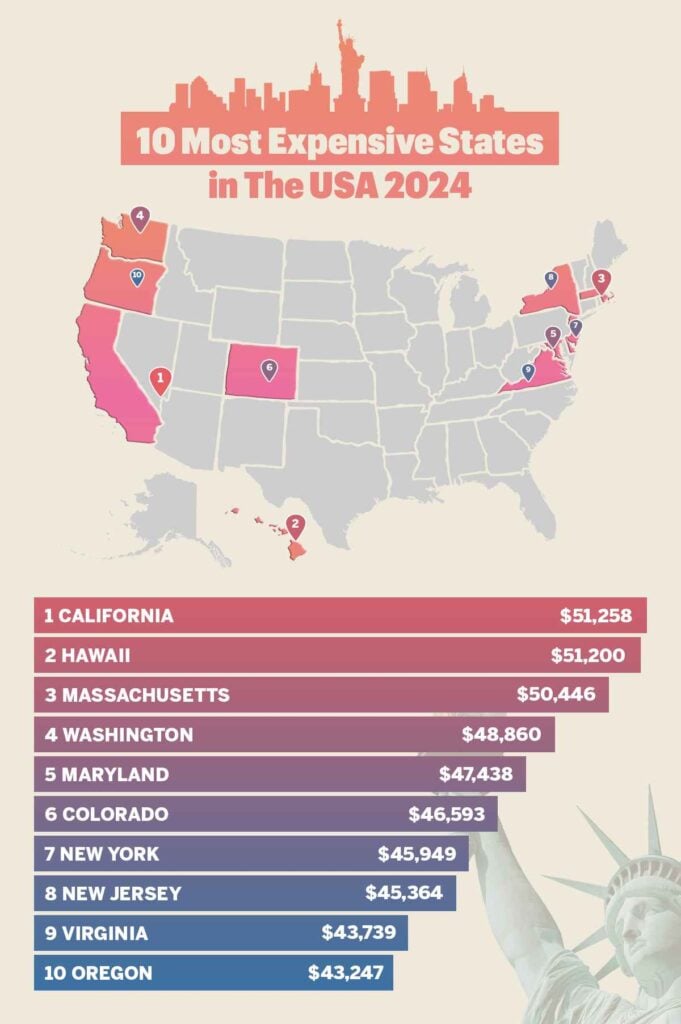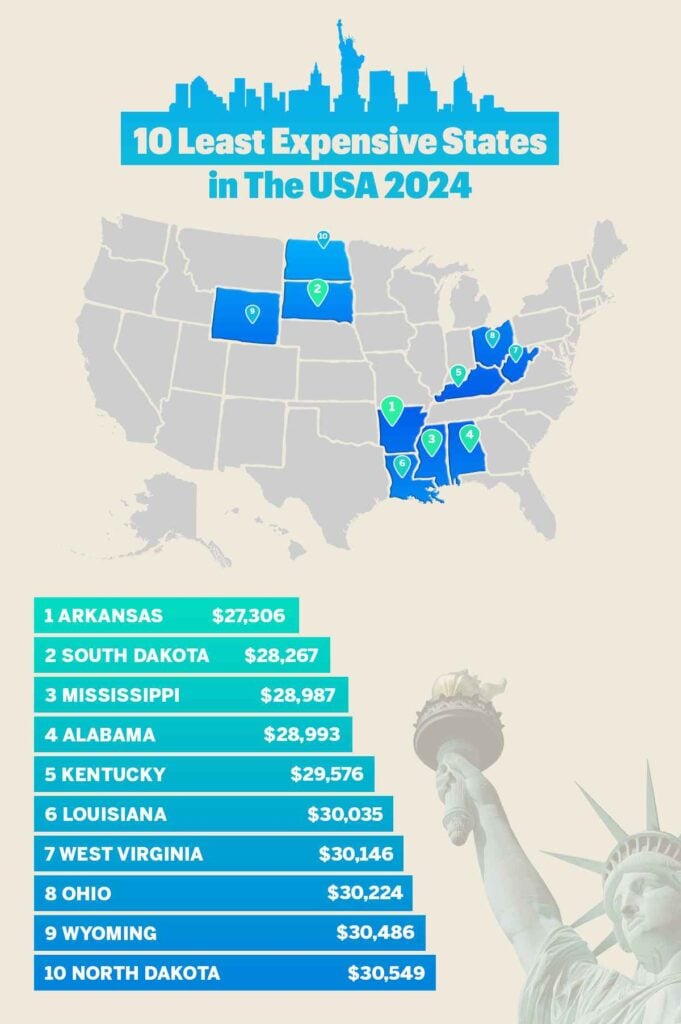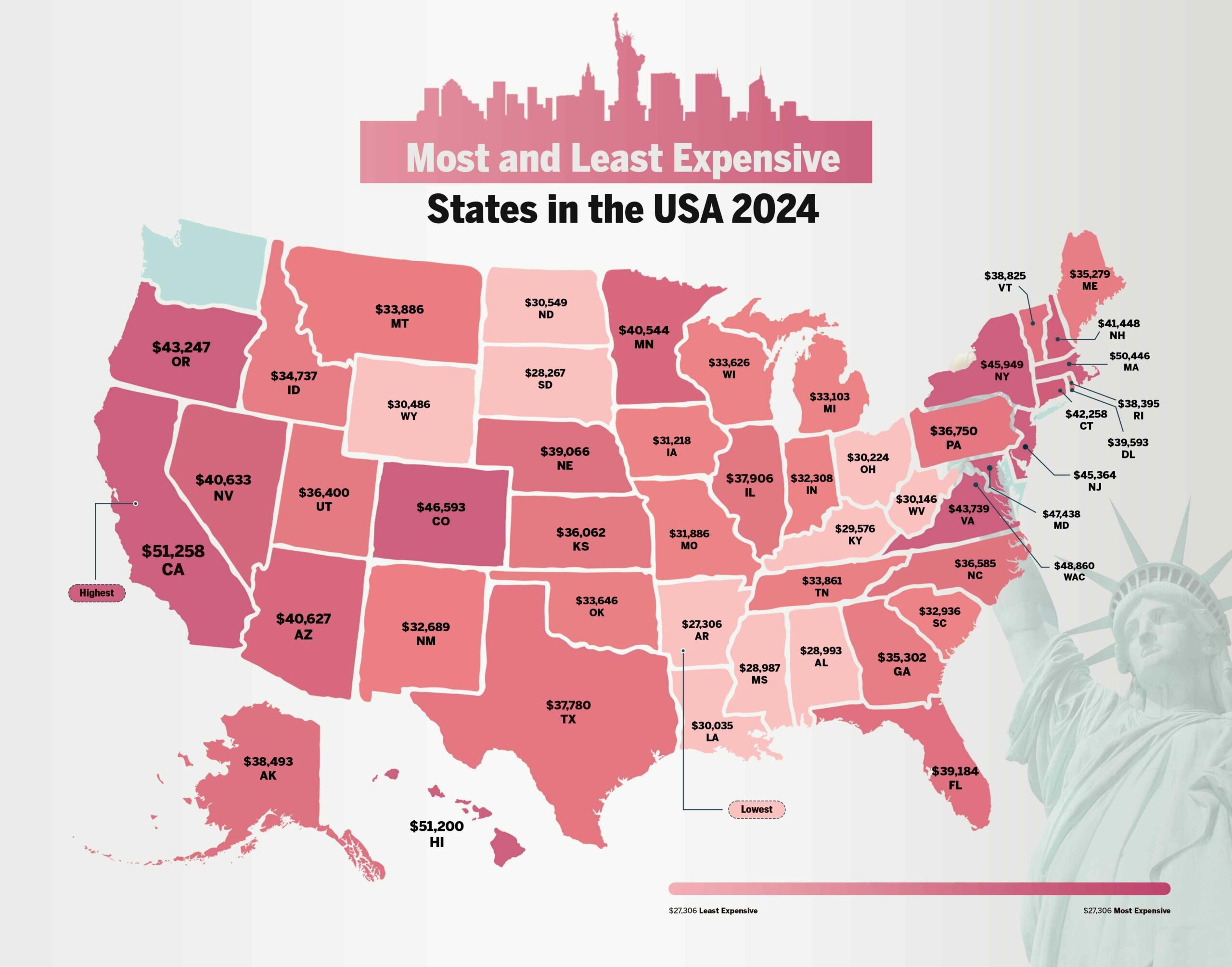Introduction
The cost of living in the U.S. varies dramatically by state, depending on factors such as housing, food, clothing, transportation, and healthcare expenses. It is important to note that these expenses place a greater financial burden on parents than on people without children.
So, understanding these differences becomes crucial for families seeking the best place to raise children while managing their budgets. In 2024, the difference between states with the highest and lowest cost of living is quite noticeable. The West Coast state of California, with its sun, sand, surf, and mountains, comes with a hefty price tag. It tops the list as the most expensive state. The combination of sky-high rents and steep daycare costs can make a living in the Golden State, a significant financial challenge for families.
On the other end of the spectrum, rural states like Arkansas and South Dakota offer a more affordable lifestyle, where lower rent and childcare costs make stretching a dollar a bit easier.
This article explores the ten most and least expensive states in the United States to live in this year, highlighting the different expenses that can affect family finances.
Key Findings:
- California is the most expensive state to live in, with the highest total annual cost of living ($51,258).
- Arkansas is the least expensive state, with the lowest total annual cost of living ($27,306).
- California also has the highest annual rent, at $22,440, and West Virginia has the lowest, at $9,540.
- The difference in food spending between two-person households with and without children per year is greatest in Hawaii ($2,481) and smallest in Kentucky ($1,704).
- Massachusetts has the highest average annual daycare cost at $21,269, whereas Mississippi has the lowest at $7,280.
- The annual cost of clothes for girls is the highest in Hawaii ($125) and the lowest in Mississippi ($95).
- Despite being the fourth most expensive state to live in, Washington has the lowest family medical expenses at $1,287 a year, while Delaware, in the middle of the list, has the highest, at $3,454.
- Families with children see the largest increase in annual transportation costs ($3,502) in Wyoming, the ninth most affordable state, whereas in New York, the seventh most expensive state, the difference is $2,430.
- In North Carolina, the annual cost of workplace insurance for a single-family plan is $4,481 higher than for two adults, while in Michigan, the difference is $844.
- Utah offers the most state tax benefits ($1,750 in exemptions or credits), while roughly one-third of all states do not.
The Most and Least Expensive States to Live in the USA 2024
10 Most Expensive States to Live in the USA 2024

1. California
California is the most expensive state in the U.S., with a total annual cost of $51,258. It has the highest annual rent at $22,440, and some of the steepest child daycare costs at $18,201. Food spending differences for two-person families with and without kids come to $2,023. Clothing expenses for girls are $123 a year, the second highest. Family medical costs an average of $2,319 annually.
Depending on whether there are kids in the family, transportation costs vary by $3,205, which is the second-highest among the ten most expensive states. Workplace insurance costs $3,347 more for a single family. On the plus side, California offers married couples a generous $400 tax benefit, the second highest in the country.
2. Hawaii
Hawaii is the second most expensive state to live, with an annual total cost of living of $51,200. This high cost is mainly driven by the average annual rent ($21,756), the second highest in the country.
For families with at least one child, the expenses really add up. Daycare costs alone average $18,044 per year. The difference in typical food spending between a two-person family without children and a two-person family with a child is $2,481 annually, the highest in the nation. Regarding clothes, the annual cost for girls is $125, again the highest in the country.
Transportation costs differ by $3,305 a year between a two-person family without children and a two-person family with a child, ranking third highest. The average difference in workplace insurance premiums for a single-family plan versus two adults is $4,010, the third highest.
Medical expenses for families are a bit of a relief, though, at $1,569 per year, making them among the lowest. Also, the state tax benefits offer a slight offset of $90 to the total annual cost.
3. Massachusetts
Massachusetts has a total annual cost of $50,446, making it the third most expensive state. The average yearly rent ($19,608) is among the steepest, and daycare costs ($21,269) are the highest. Food spending differs by $2,193 for two-person families with and without children, the third-highest difference in the country. Annual clothing expenses for girls are $117, and family medical costs average $2,347. Transportation costs can vary by $2,944, depending on whether there’s a child in the family. Workplace insurance costs $2,018 more on average for a single-family plan. So it’s somewhat of a good thing that the state offers parents a $50 return on their yearly tax.
4. Washington
Washington State comes in fourth with a total annual cost of $48,860. The average yearly rent ($19,560) is close to Massachusetts’s. Daycare costs are the second highest in the country at $19,200 per year. Food spending differences between two-person families with and without children are $2,109. The average yearly spending on clothes for girls is $120, the third highest. Surprisingly, Washington has the cheapest annual medical expenses for families at $1,287. Transportation costs are also lower as they differ by $2,987 between families with and without children. However, the average annual cost for workplace insurance is substantially ($3,597) more for a single-family plan. Moreover, there are no state tax exemptions or credits available.
5. Maryland
Maryland ranks as the fifth most expensive state, with a total annual cost of $47,438. The annual average rent ($18,600) and daycare expenses ($17,889) are high. Food spending varies by $2,078 annually between two-person families with and without children. Clothing expenses for girls ($117 per year) and medical expenses for families ($2,879 annually) are also quite expensive. Transportation costs differ by $2,986 between families with and without children, and workplace insurance costs $3,041 more for a single-family plan. Fortunately, parents get some relief, with state tax benefits totaling $152 yearly.
6. Colorado
Colorado ranks as the sixth most expensive state to live in, with a total annual cost of $46,593. The average annual rent is $19,752. Families spend $2,035 more on food if they have a child. Childcare costs at daycare centers average $15,881 per year. Annual spending on clothes for girls is $113. Medical expenses for families average $2,329 annually. Transportation costs increase by $2,905 for families with children. Workplace insurance costs $3,578 more for a single-family plan than for two adults. Unfortunately, there are no state tax exemptions or credits available in Colorado.
7. New York
New York ranks seventh with a total annual cost of $45,949. Rent here is somewhat lower ($17,988) than other expensive states. However, daycare costs average $18,574 per year, the third highest in the country. Food spending differences for two-person families with and without children are $2,141, which is pricey. The average annual spending on clothes for girls is the same as in Washington ($120). Medical bills for families are fairly expensive ($2,442 per year). Depending on whether there’s a child in the family, transportation costs vary by $2,430, which is surprisingly the lowest in the country. For a single-family plan, premiums for workplace insurance cost $2,314 more than they do for two adults. Meanwhile, the state tax provides parents with $60 in exemptions or credits on their annual tax.
8. New Jersey
New Jersey is the seventh most expensive state, with a total annual cost of $45,364. Rent averages $18,660 a year, and daycare costs hit $17,460. There’s a $2,068 difference in food spending between two-person families with and without children. Clothing expenses for girls run about $120 annually, and family medical costs average $2,268. Transportation costs vary by $2,935 based on whether you have kids. Workplace insurance costs about $1,936 more a year for a single family. Plus, state tax benefits offer an $83 rebate.
9. Virginia
Virginia ranks ninth on the list with a total annual cost of $43,739. Rent averages $17,292 annually, and childcare costs are around $15,288. If you have kids, you’ll spend about $2,013 more on food than families without children. Clothing expenses for girls come to about $113 annually. Family medical costs average $2,531 a year, and transportation costs vary by $3,000 depending on whether you have children. Workplace insurance costs about $3,555 more for parents. Virginia offers a modest tax benefit of $53, slightly offsetting the overall expenses.
10. Oregon
Oregon rounds out the top ten most expensive states, with a total annual cost of $43,247. Rent averages $16,440 a year, and childcare costs about $15,786. Families with kids spend around $2,048 more on food than those without. Clothing expenses for girls are about $113 a year. Family medical costs average $2,153 annually. Depending on whether you have children, transportation costs vary by $2,915, which is relatively low. Workplace insurance costs $4,005 more for a single-family plan than for two adults, which is on the pricier side. Plus, you get a substantial $213 benefit from state tax exemptions or credits.
10 Least Expensive States to Live in the USA 2024
 1. Arkansas
1. Arkansas
Arkansas is the least expensive state in which to live in the U.S., with a total annual cost of $27,306. The state has the second-lowest average rent of $10,152 a year. For a two-person household with a child, food costs about $1,735 more than for one without kids, which is reasonable. Daycare costs are also affordable at $7,431 a year, the third least expensive in the country. Clothing for girls aged 2 to 16 costs around $98 annually, a bargain.
Meanwhile, families in Arkansas have some slightly higher expenses. For example, family medical expenses average $1,671 annually, and transportation costs are $3,142 more for households with children. Health insurance premiums for a single-family plan are $3,106 more than for two adults.
However, the state does offer a $29 tax benefit for parents.
2. South Dakota
South Dakota is the second least expensive state, with a total annual cost of $28,267. Rent is quite affordable at $10,392 a year. If you have a child, food costs about $1,941 more than if you don’t. Daycare costs are $7,426 annually, the second lowest in the country. Clothing for girls costs a reasonable $99 a year—medical expenses average $1,795 annually. Like in Louisiana, transportation costs rise for households with children (by $3,281), one of the highest differences. Health insurance premiums for a single-family plan are $3,333 more than for two adults, also on the higher side. Moreover, the state doesn’t offer any tax benefits.
3. Mississippi
Mississippi is the third least expensive state to live in, with a total annual cost of $28,987. Rent is pretty low at $10,476 a year. If you have a child, food costs about $1,783 more yearly than if you don’t, which is not so pricey. Daycares are reasonably priced at $7,280 annually. Clothing for girls costs the cheapest here at just $95 a year.
Meanwhile, family medical expenses average $2,932, one of the highest. Transportation costs increase by $3,259 for households with children, which is also higher. Health insurance premiums for a single-family plan are $3,237 more than for two adults, which is relatively stiff. On the upside, Mississippi parents enjoy a $75 return on their annual taxes.
4. Alabama
Alabama is the fourth most affordable state, with a total annual cost of $28,993. Rent is pretty low at $10,956 a year. For a two-person household with a child, food costs about $1,897 more than for one without kids, which is not so pricey. Daycare is fairly affordable, too, averaging $7,800 a year. Clothing for girls costs around $97, the second cheapest compared to other states.
Meanwhile, medical expenses for families average $1,889 per year, and transportation costs increase by $3,161 if you have children. Health insurance premiums for a single-family plan are $3,218 more than for two adults. These expenses are relatively high. But, similar to Arkansas, Alabama offers a small ($25) return on taxes filed by married couples.
5. Kentucky
Kentucky is the fifth least expensive state, with a total annual cost of $29,576. Rent is pretty affordable at $10,692 a year. The difference in food spending between a two-person household with and without a child is the lowest, at $1,704. Center-based child care also costs a reasonable $9,685 annually. Families spend around $98 a year on girls’ clothes, which is inexpensive. Medical costs are moderate at $2,137 annually. For households with kids, transportation costs go up by $3,138, a bit higher. Health insurance premiums for a single-family plan are $2,122 more than for two adults—this difference is relatively low. Unfortunately, the state doesn’t offer any tax benefits.
6. Louisiana
Louisiana is the sixth least expensive state to live in, with a total annual cost of $30,035. Rent is relatively low, at $11,808 a year. For a two-person household with a child, food costs about $1,855 more than for one without kids. Daycare costs average $8,580 annually. Clothing for girls costs around $100 a year. Medical expenses are pretty affordable, averaging $1,457 annually. However, transportation costs go up by $3,076 if you have children. Health insurance premiums for a single-family plan are $3,199 more than for two adults. The state offers a $40 tax benefit.
7. West Virginia
West Virginia is the seventh least expensive state, with a total annual cost of $30,146. Rent is the lowest in the country at $9,540 a year. Food costs are about $1,717 more if you have a child than a two-person household without kids. Childcare costs at daycare centers average $10,140 per year. Families spend around $100 a year on girls’ clothes. Medical expenses are pretty low, averaging $2,583 annually. Transportation costs for households with kids increase by $3,099, the lowest increase among the least expensive states.
Health insurance premiums for a single-family plan are $3,097 more than for two adults, which is relatively low. Plus, there’s a state tax credit of $130.
8. Ohio
Ohio is the eighth least expensive state, with a total annual cost of $30,224. Rent is around $11,388 a year. If you have a child, food costs about $1,867 more than for a household without kids. Child care at a daycare center averages $10,118 per year. For girls’ clothes, families spend about $102 annually. Family medical expenses come to around $1,511 a year. Transportation costs go up by $2,978 with kids. Health insurance premiums for a single-family plan are $2,321 more than for two adults. Ohio also offers a $61 tax benefit.
9. Wyoming
Wyoming is the ninth least expensive state, with a total annual cost of $30,486. Rent averages $10,740 a year, which is affordable. Food costs for a two-person household with a child are a reasonable $1,917 more than for one without. Center-based child care at $10,060 annually is comparatively high. Families spend just about $101 a year on clothes for girls.
Meanwhile, medical expenses average $2,203, a bit higher, and transportation costs go up by $3,502 for households with children, the highest in the country. However, health insurance premiums for a single-family plan are $1,963 more than for two adults, which is relatively low. Unfortunately, the state doesn’t offer any tax benefits.
10. North Dakota
North Dakota is the tenth most affordable state in the U.S., with a total annual cost of $30,549. The average yearly rent ($10,356) here is the third-lowest in the country.
Food spending increases by $1,875 for families with a child. Daycare costs average $9,925 per year. Girls spend $100 annually on clothes. Medical expenses for families average $1,880 annually. These expenses are largely on the lower side.
However, some costs are higher here compared to other states. Transportation costs rise by $3,237 for families with children, which is very expensive. Workplace insurance costs $3,176 more for a single-family plan than for two adults, which is also on the higher side. Meanwhile, North Dakota does not offer state tax exemptions or credits.
Conclusion
The cost of living in the United States varies greatly across different states, influenced by factors such as housing, childcare, food, transportation, and healthcare expenses.
Understanding these differences is crucial for families planning to manage their budgets effectively.
While states like California offer beautiful landscapes but have a high cost of living, states like Arkansas and South Dakota provide a more affordable lifestyle.
Considering these variations, families can make informed decisions on where to live based on their financial priorities and needs.
Methodology:
Our analysis examined all 50 U.S. states to evaluate the average annual cost of raising a child in a two-earner household. We considered several expense categories: rent, food, child care, apparel, medical, transportation, and health insurance premiums. The total costs for each category were summed to determine the overall financial burden for families in each state. This straightforward approach allowed us to compare child-rearing costs across the states clearly.
Methodology – further details
We used various data sources to calculate the average annual cost of raising a child in a two-earner household in each state.
Our calculations incorporated expenses for rent, food, child care, apparel, transportation, and health insurance premiums. Dependent tax benefits — exemptions or credits — were subtracted from expenses to create the average annual cost to raise a child by state.
All data is state-based for our study. Here’s a look at the categories and how they were calculated:
- Rent: The gross median rent annually. Monthly data is collected from the U.S. Census Bureau American Community Survey and multiplied by 12.
- Food: The difference in typical food spending between a two-person household and a two-person household with a child, calculated by region. (Massachusetts Institute of Technology (MIT) Living Wage Calculator)
- Child care: The annual price of center-based child care by state, representing the average cost for one child at a daycare center. We used various sources due to data availability. (Child Care Affordability Analysis 2021 from Child Care Aware)
- Apparel: The average yearly spending on apparel for girls ages 2 to 16 reflects typically higher expenditures than boys’ clothing. (U.S. Bureau of Labor Statistics)
- Medical: The average annual medical expenses families incur, including out-of-pocket health service costs. This is calculated by state. (Kaiser Family Foundation)
- Transportation: The difference in typical transportation spending between a two-person household and a two-person household with a child, calculated by region. (Massachusetts Institute of Technology (MIT) Living Wage Calculator)
- Health insurance premiums: The average annual cost of premiums for workplace insurance for two adults compared to a single-family plan. (Kaiser Family Foundation)
- State tax exemptions or credits: This calculation assumes that two parents filing jointly earn the national median income for families. For exemptions, the subtracted amount is the exemption amount multiplied by the marginal tax rate for that income. For credits, the dollar amount of the credit is applied. (Tax Foundation)
We assumed parents’ tax returns were filed jointly with a combined income of $85,028 (the national median income among families in 2021, the latest year for which data was available).


 Tags:
Tags:










